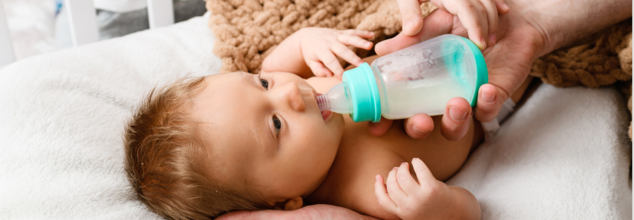- Health Conditions A-Z
- Health & Wellness
- Nutrition
- Fitness
- Health News
- Ayurveda
- Videos
- Medicine A-Z
- Parenting
- Web Stories
Breastfeeding Moms Are Mixing Formula & Breast Milk-Should You?

Image Credit: Canva
Struggling with low milk supply and sleepless nights, new mothers often find breastfeeding both rewarding and exhausting. The constant worry about baby’s nutrition, latching issues, and painful nursing sessions make them question if they was doing enough.
On the other hand, breastfeeding is both rewarding and challenging. Mothers greatly cherish the bonding experience. However, others face low milk supply, exhaustion, or demand upon returning to work. In such a case, combination of breast milk with formula is usually the solution at hand, better known as combo feeding. So, is this safe? How do you correctly mix your breast milk with your baby's formula? Let me tell you about everything there's to know so that you're able to maximize your baby's nutrition, just making things more manageable for yourself.
Why Some Moms Make the Decision To Mix Breast Milk and Formula
Some mothers mix breast milk and formula based on personal choice. The reasons for doing so are numerous, but the most common include the following:
- Some mothers do not have enough milk to fully feed their baby.
- Pumping regularly at work is not always possible, so supplementing with formula is convenient.
- Breastfeeding twins or more is very exhausting, and formula can help fill in the gaps.
- Some mothers find that formula feeding at night helps their babies sleep longer.
- Gradual introduction of formula can help a baby get accustomed to the new taste and consistency.
Is it Safe to Mix Breast Milk and Formula in the Same Bottle?
Yes, you can mix breast milk and formula in the same bottle as long as you prepare it according to proper guidelines. Both the American Academy of Pediatrics (AAP) and the World Health Organization (WHO) recommend exclusive breastfeeding for the first six months, but they acknowledge that supplementing with formula is sometimes necessary.
The antibodies, proteins, and essential nutrients in breast milk are tailored for your baby. Formula, on the other hand, offers a steady and predictable source of nutrition. Mixing them gives you the chance to benefit most from both.
Pros and Cons of Mixing Breast Milk and Formula
Pros
Mixing the two can be done directly in one bottle and can cut down the number of feedings as well as bottle cleaning.
Infants take in all the immunity-boosting benefits of breast milk.
The other caregivers can feed him/her to give her the needed break.
It is easy for the mother to return to work without abrupt weaning.
Cons
Breast milk lasts as long as four hours at room temperature, but once mixed with formula, it should be consumed within two hours.
Some babies may take time to digest formula.
If the formula is not mixed properly, the balance will be disturbed when it comes to nutrition.
How to Safely Mix Breast Milk and Formula
To make sure your baby receives the proper nutrition without any forms of adverse health effects, one can follow this step:
Step 1: Prepare the Formula Correctly
Never use breast milk in place of water when mixing the formula. This will establish an unsafe calibration of nutrients, which is dangerous for your baby. Use the following strategy:
- Always observe the instructions from the manufacturer on the container.
- Measure out the amount of water first and then the amount of formula.
- Mix well or shake to dissolve it properly.
Step 2: Add Breast Milk
After preparing the formula, you can add expressed breast milk to the bottle. Ensure that:
- The breast milk is safely stored (freshly pumped, refrigerated, or thawed from frozen).
- The mixture is consumed within two hours at room temperature or within 24 hours if refrigerated.
Step 3: Serve Immediately or Store Safely
- If your baby starts drinking the bottle but doesn’t finish, discard the remaining milk within one hour.
- Do not reheat mixed bottles, as this can alter the nutrients in breast milk.
To minimize waste, some experts recommend offering breast milk first. If your baby is still hungry, follow up with a separate bottle of formula. This method ensures that none of your hard-earned breast milk goes to waste.
If you decide to mix breast milk and formula, it’s important to listen to your baby and your body. Start slowly by introducing formula gradually to monitor how your baby reacts and ensure a smooth transition. Using the right bottles can make a big difference—some nipples and bottle designs mimic breastfeeding, helping babies adjust more easily. There are several points a breastfeeding mom should keep in mind: she needs to take good care of her health and hydration system in order to maintain proper milk supplies, and in case of any medical information a baby has, it is always best to consult a pediatrician because every infant is different and requires a specific feeding plan.
Breast milk and formula do not necessarily have to be an either-or proposition. When you want to solely breastfeed or supplement your baby with formula, the most important thing is that the baby's on time, healthy, and happy. If combo feeding makes life easier while also ensuring that your baby is well-nourished, then it is a valid and beneficial choice.
How to Safely Prepare Baby Formula With Water Opens a new window. American Academy of Pediatrics, 2022
Infant Formula Preparation and Storage Opens a new window. CDC. 2022
Questions & Answers for Consumers Concerning Infant Formula Opens a new window. FDA. 2022
To Be A Mother With Multiple Sclerosis: Actor Christina Applegate Gets Candid About Her Diagnosis And How It Changed Motherhood

Credits: Wikimedia Commons
"I miss who I was too," says the Christina Applegate, revealing her emotional conversation with daughter Sadie
She is speaking candidly about how life with multiple sclerosis (MS) has changed not just her, but her relationship with her daughter.
The Dead to Me actress, 53, recently shared an emotional moment from a conversation with her 14-year-old daughter, Sadie, on the Let’s Talk Off Camera with Kelly Ripa podcast. Diagnosed with MS in 2021, Applegate has gradually withdrawn from public life as she navigates the daily physical and emotional toll of the condition.
“I don’t get up in the morning with that,” she said, referring to any sense of personal motivation. “I get up because of her. She’s the reason I’m still here and trying.”
But that strength has been tested in ways that have cut deep—especially as a mother. During their recent conversation, Sadie told her something that Applegate says "was like a knife to the heart."
“She said, ‘I miss who you were before you got sick.’ And I do too,” Applegate said, holding back tears. “I miss that version of me very much.”
The toll of daily life with MS
Applegate has never shied away from speaking about the realities of living with multiple sclerosis.
On Conan O’Brien’s podcast earlier this year, she revealed that she rarely leaves the house anymore. The pain and fatigue have become too overwhelming.
“If people saw what my life was like on the daily, they wouldn’t be able to do it. Because I can sometimes not do it. It’s really, really hard,” she admitted.
And that physical struggle directly impacts her ability to parent. Once an active, involved mom, picking up her daughter from school, dancing with her at home, volunteering in the school library, Applegate now says that version of herself is gone, and her daughter has noticed the change.
“She’s had to see the loss of her mom, in the way that I was a mom with her,” Applegate told PEOPLE in an earlier interview. “She doesn’t see those things anymore. This is a loss for her as well.”
There are days, she added, when the pain is so severe that Sadie simply knows not to ask anything of her. “If she sees that I’m laying on my side, she knows she can’t ask me to do anything. And that breaks me,” Applegate said. “I love doing things for her. I just can’t sometimes. But I try. I try.”
What is multiple sclerosis?
As per the National Institute of Neurological Disorders and Stroke, multiple sclerosis is a chronic, often disabling neurological condition that affects the central nervous system, the brain, spinal cord, and optic nerves. It is an autoimmune disorder, meaning the body’s immune system mistakenly attacks healthy cells, in this case, the protective sheath (myelin) surrounding nerve fibers.
Without intact myelin, nerve signals slow down or get interrupted, leading to a range of symptoms that vary from person to person. These may include muscle weakness, fatigue, numbness, coordination issues, vision changes, and memory problems.
Most people are diagnosed between the ages of 20 and 40, although it can occur earlier or later. MS does not have a cure, but treatments can help manage symptoms and slow disease progression. The severity of symptoms also differs, some people experience mild, manageable relapses, while others gradually face increasing disability.
Life with MS: A new normal
One of the most difficult aspects of MS is its unpredictability. Symptoms can flare up unexpectedly and may disappear for long stretches. While the disease doesn’t typically shorten life expectancy, it does require a major adjustment in daily life.
In Applegate’s case, it has meant redefining her identity, not just as an actress, but as a mother and a person. Still, despite the pain and fatigue, her love for her daughter keeps her grounded and trying.
“Sadie is the reason I’m still here. She gives me the strength to keep going,” Applegate said.
Children’s Brain Development Sees Improvement With More ‘Green Time’ - Study Finds

(Credit-Canva)
A big concern for parents these days is how kids are seemingly swallowed by technology. They no longer plead to go out and play for ‘just five more minutes’. The serotonin and dopamine boost we used to crave while playing outside as kids, does not seem like a big deal any longer. Could this be due to the increase in electronic device usage?
Parents who are worried about their kids screentime are right to be concerned. Many studies have shown the increased screentime slows down brain development. If certain habits can slow down brain development, are there others that can increase brain development?
A new study published in the Environment International journal suggests that living close to green areas, like parks or forests, might lower a child's chance of developing problems like ADHD and autism. This protective effect seems to start even before they are born.
How Green Spaces May Help Before and After Birth
The study found that children were less likely to experience brain development problems if their mothers lived near green spaces before or during pregnancy. The same benefit was seen if the children themselves lived near green spaces when they were infants. These important findings were published in a science journal called Environment International. One of the lead researchers pointed out that having more access to green spaces in cities could truly support healthy brain development in young children and help reduce the number of developmental delays.
Why Green Spaces Might Be Good for Brains
Scientists don't fully understand yet exactly how green spaces might help a baby's brain grow healthily, even while still in the womb. However, they have some ideas. They believe that being around nature can reduce stress and feelings of sadness, encourage people to spend more time with others, and lower exposure to loud noises and very hot or cold temperatures. All of these things could be good for a young child's overall development.
What the Study Discovered
For this research, scientists looked at a lot of information from over 1.8 million mothers and children who were part of the Medicaid program in different states. They used satellite images and the mothers' home addresses to figure out how much green space they lived near. The results were quite interesting:
- Children whose mothers lived near green spaces had a 34% lower risk of intellectual disabilities.
- They also had a 17% lower risk of autism.
- For children who lived near green spaces themselves after they were born, the study found a 19% lower risk of learning disabilities.
The researchers noticed that these protective effects were present at different stages: before pregnancy, during pregnancy, and in early childhood. This suggests that there might be various biological reasons why green spaces are helpful at different times.
Stronger Benefits in City Areas
The study showed that the protective effects of green spaces were even stronger for children living in city areas and for children from Black or Hispanic families. This suggests that green spaces might provide an even greater benefit in places where they are not as common. Increasing access to green spaces in city environments could really support early childhood brain development and help reduce the number of developmental delays.
What We Still Need to Learn
It's important to remember that this study can't prove that living near green spaces directly causes healthier brain development. There could be other factors that also play a role in a child's risk for developmental problems.
Future research will dive deeper into the exact reasons why green spaces might benefit children's brain development. They also want to explore whether different kinds of green spaces—like parks, walking trails, or playing fields—offer different levels of benefit.
Expecting Soon? A New Research Suggests That Your Baby's Sex Is Not Random

Credits: Canva
A baby’s sex at birth might not be the equal coin toss that we’ve always believed it to be. A new study published by the Harvard TH Chan School of Public Health, titled, “Is sex at birth a biological coin toss? Insights from a longitudinal and GWAS analysis” challenges this long-held assumption.
The study was published on July 18 in the journal Science Advances, and it found that several factors, including a mother's age, genetics, and the sex of older siblings—may influence whether she’s more likely to have a boy or a girl.
Patterns Behind the Birth of Boys and Girls: How Was The Study Conducted?
The research looked at more than 146,000 pregnancies involving over 58,000 U.S. nurses from the NIH-funded Nurses’ Health Study, covering the years 1956 to 2015. What they found was eye-opening: families with three or more children were more likely to have either all boys or all girls than if the sex of a child was purely random.
“If you’ve had two or three girls and you’re trying for a boy, your odds aren’t 50-50 anymore,” explained Jorge Chavarro, professor of nutrition and epidemiology and the study’s senior author, in a quote to The Washington Post. “You’re more likely to have another girl.”
Also Read: It Might Not Be Diabetes; It Could Be This Common Pill Causing Heart Disease: Study
The Role of Maternal Age and Genetics
One of the biggest surprises was the link between maternal age and the likelihood of giving birth to all children of the same sex. Women who started having children after age 28 had a slightly higher chance of giving birth to only boys or only girls.
Researchers believe this could be due to biological changes that come with age, such as shifts in hormone levels or physical conditions that may affect which sperm survive and fertilize the egg.
Additionally, the study identified two specific genes that appear to be linked with the likelihood of having children of only one sex. While scientists don’t yet know how these genes affect birth sex, their discovery opens the door for further research.
Chavarro noted that future studies should explore whether lifestyle choices, diet, or even exposure to certain environmental chemicals might also play a role.
Are Families Subconsciously Seeking “Gender Balance”?
The study also touches on social patterns. In families with two children, there was a higher chance of one boy and one girl. Researchers believe this may be because couples tend to stop having children once they have one of each sex, possibly due to a preference for a “balanced” family.
This idea is supported by another paper published in the Journal of Behavioral and Experimental Economics, which jokingly refers to parents who have three boys or three girls as those who “lose the birth lottery.”
When Expectations Don’t Match Reality
The findings also bring up the topic of “gender disappointment”, a real emotional experience for some parents when the sex of their baby isn’t what they hoped for.
A 2023 paper in the BJPsych Bulletin found that in many Western families, this disappointment often stems from a desire to experience raising both sons and daughters.
In everyday life, these expectations can be seen in subtle remarks like “Four boys? Poor you,” or “Still trying for a girl?”, comments that reflect how deeply society views gender roles and balance, reports CBC.
What It Means for Expecting Parents
While the science behind birth sex is clearly more complex than a simple 50-50 chance, experts agree it’s not something to stress over. Rather, it’s a reminder that biology, age, genes, and personal choices all come together in ways we’re only beginning to understand.
© 2024 Bennett, Coleman & Company Limited

